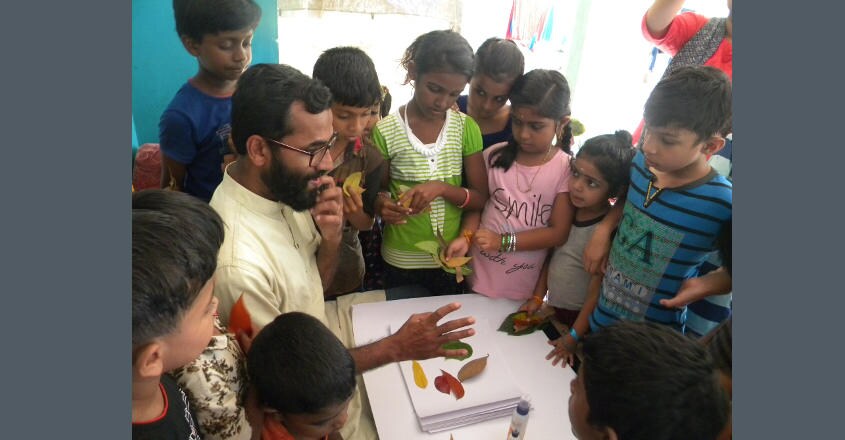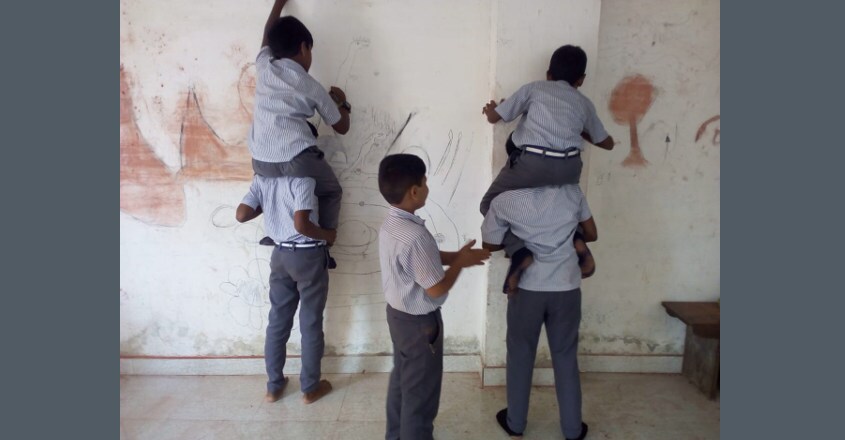How biennale’s famed ‘art room’ came into being, why they must go on
%20at%20a%20workshop%20by%20artist%20John%20Baby%20(left)%20at%20the%20art%20room%20of%20the%20Kochi-Muziris%20Biennale%20in%20December.jpg?w=1120&h=583)
Mail This Article
The green and placid locale that functions as the hub of the ‘art room’ of the Kochi-Muziris Biennale today belies the tumult behind the run-up to such a talent-grooming nursery that came up alongside the mega festival. The ongoing fourth edition of the 108-day biennale will conclude in March-end, but the ‘art room’ as an exercise is set to continue for the benefit of generations to come in its host state.
So, what is art room and how did it come into being? Well, the rudiments of the initiative go back to the floods that ravaged Kerala during last monsoons. The severity of the August 2018 calamity had numbed the minds of children, especially those living along rivers that swelled menacingly in the week-long rains. By the end of that month, skies had turned bright and nature overall did mellow for mankind, but little ones who underwent the trauma showed bleak signs of a smooth comeback to normalcy in routine.
That was when Blaise Joseph thought he should join nascent voluntary movements that sought to balm the hearts of school students who were struggling to attend their classes for want of concentration. Having been deep into art education as focal to community projects as one trained in the famed MS University of Baroda in Gujarat, he was making moves to live for a while in his native Malabar’s hilly terrain. It was from a northeast corner of the state Blaise had left upcountry a quarter century ago to pursue higher studies.

Blaise, who was living last year in Kolkata with his artist-wife Atreyee Day, had just come to his native village near Iritty of Kannur district when the monsoon rains began to further pick up. “A week before what turned out to be Kerala’s biggest calamity in a century, we had couple of houses in the neighbourhood just partly going down the soil,” he notes, about the surroundings in Edoor, lined by the slender Vempuzha river. “In fact, my own house had a corner where the steep mound of red earth looked threatening to collapse any time amid incessant downpours.”
Soon happened the deluge. In the high-altitude Edoor by the Western Ghats, the calamity meant not only floods, but landslides as well. Blaise learned that situation was still worse downstate, more so in riverine stretches along the much broader Periyar and Chalakkudy rivers in central Kerala. Just as the rains showed signs of subsiding, Blaise left for those areas — with the aim of helping little children shocked by the massive destruction that had thrown their lives out of gear.

There, like-minded people charted out an action plan without delay. Soon it found a platform on social media what with the formation of a WhatsApp group. Named ‘Artists For Kerala’, it began finding warm response from teachers, students and social workers. “Activists and organisations from even faraway cities like Delhi and Mumbai started to come in with help,” notes Blaise, who had earlier, since the middle of this decade, been engaged in such art work in rural north Karnataka with Atreyee, a Bengali.
“I don’t attach much importance to concepts like trauma care and art therapy. For, calamities have happened all across the history of mankind. More than anything, it is community feeling we need to foster in such situations,” says Blaise. In fact, he had, with Atreyee, carried out a 2014-15 project in Belgaum of the Deccan region, intensely engaging teachers and children by introducing them to a variety of art activities such as drawing, collage-making, painting, murals and gardening. “It’s the spirit of social togetherness that matters more than anything in such moments of tragedy.”
The artists’ collective volunteered to work for the benefit of post-flood children at their schools. The response was encouraging. “We spent the whole month of September in such community work. The activities were not limited to just drawing or painting, but to exercises related to, say, acting, singing, dancing, drumming, body movements of various kinds,” says Blaise. “The focus was to reconnect with society, with nature. To make the younger generation realise how much the modern world has distanced form Mother Earth and what all could be the dangers of such a life. We stressed a lot on how interpersonal behaviour, too, is vital for an artist to grow.”

Gothuruth by the Periyar, Kerala’s longest river that had breached its banks and flooded much of the low-lying area near Aluva in Ernakulam district, was where the collective launched its work. That was where the concept of the ‘art room’, too, took shape as a first endeavour of its kind in the highly literate state. “It isn’t necessarily to groom children talented in drawing or painting. See, art is very important in the development of a child; to be exposed to it is even a basic right,” Blaise says, quoting specifically the Syllabus of Art Education set by the NCERT as an autonomous establishment under the government. “We began working with students of classes between 5 and 8, also because they can best be handled.”
Soon the work found similar venues in other schools of the area, even including those by the Chalakkudy river of neighbouring Thrissur district. “We weren’t wrong in our notion that the new generation is generally removed from both society and nature. In their art engagements, we made it a point they used resources from the surroundings. Clay became one medium, the others being juices from leaves and fruits. Twigs were another input in the artworks,” points out Blaise. “In fact, anything from nature.”
It was amid such work in post-monsoon Kerala last year that the Kochi Biennale Foundation (KBF) stumbled upon Blaise in its run-up to the fourth edition of the contemporary art festival slated to begin in December. That was after Delhi-based art curator Vidya Shivadas, who also studied from MS University, referred Blaise to the KBF’s founder-secretary Riyas Komu.
“We were anyway looking for a biennale-allied programme that would help children in blooming their artistic talent,” says Riyas, a top Kerala-born artist based in Mumbai. “Much of what Blaise had conceived in this respect sounded so close to what the KBF was thinking of running.” Thus, on October 10, two months ahead of the fourth biennale, Blaise joined the festival team as the programme head of the KBF’s ABC, that is ‘Art By Children’. In November, the foundation conducted a three-day workshop that groomed ‘art facilitators’ following a series of intensive pre-programme sessions that equipped them with skills required to groom talents.
Not surprising, thus, that the art room that was opened on December 15 at the leafy Cabral Yard venue of the biennale in Fort Kochi follows the spirit of community feeling and respect for nature. As KBF founder-president Bose Krishnamachari notes, the art rooms have trained teachers working as facilitators for children to create studio spaces and interact between themselves. “It has been featuring workshops by experts from within Kerala and outside, including foreign countries,” he notes. “All the same, close to ten schools under the ABC are running art rooms back on their campus.”
So, even as the KBF continues to unroll a series of workshops on varied activities at the biennale art room, similar setups adorn schools in Ernakulam and Thrissur districts. Be it at the heritage town of Gothuruth (known for its traditional Biblical dance-drama called Chavittunatakam) or the tribal belt of Vettilapara near the famed Athirappilly waterfalls east of Chalakkudy, certain educational institutions are housing nurseries that promote community-centric artistic development among children.

“We let children rather unfettered. The initial drills are all centred around removing inhibitions,” points out Blaise, who had in March 2018, moved to Atreyee’s house in Kolkata after their stay in the country’s south. “We want the kids to observe nature and come up with stories based on self-experience. Such exercises are meant for early maturity. The teachers too feel thrilled; they are impressed with the children’s abilities too.”
Blaise believes that the art rooms in the schools must continue even after the end of the fourth biennale this month. “Of course, we will come up with an analytical report on the activities and present it to the government of Kerala. It is for the administration then to arrive at its conclusions,” he notes. “We would ideally like the government to undertake such initiatives. After all, it’s a system that aims to promote multiple intelligence.”

